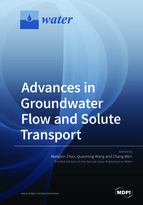Advances in Groundwater Flow and Solute Transport: Pushing the Hidden Boundary
A special issue of Water (ISSN 2073-4441). This special issue belongs to the section "Hydrology".
Deadline for manuscript submissions: closed (31 July 2017) | Viewed by 56767
Special Issue Editors
Interests: groundwater hydrology; flow and transport in geological formations
Special Issues, Collections and Topics in MDPI journals
Interests: coupled well-aquifer flow; non-Darcian flow; non-Fickian solute transport; multi-phase flow
Interests: flow and transport in low-permeability media; non-Darcian flow in porous and fractured media and its impact on transport; numerical and analytical techniques for solving groundwater problems
Special Issue Information
Dear Colleagues,
Study of groundwater flow and solute transport has been advanced into new territories which are beyond conventional theories, such as Darcy’s law and Fick’s law, in recent decades. The studied media change from permeable porous and fractured ones to much less permeable ones, such as clay and shale. The studied pore sizes also change from millimetres to micro-meters or even nano-meters. The objective of this Special Issue is to report recent advances in groundwater flow and solute transport that push the knowledge boundary into new territories which include, but not limited to, flow and transport in sloping aquifer/hillslopes, coupled unsaturated and saturated flow, coupled aquifer-vertical/horizontal/slant well flow, interaction of aquifer with connected and disconnected rivers, non-Darcian flow, anomalous transport beyond the Fickian scheme, flow and transport in extremely small pore spaces such as shale and tight sandstones. Contributions focusing on innovative experimental, numerical, and analytical methods for understanding unconventional problems, such as the above-listed ones, are encouraged, and contributions addressing flow and transport at interfaces of different media and crossing multiple temporal and spatial scales are of great value.
Dr. Hongbin Zhan
Dr. Zhang Wen
Dr. Quanrong Wang
Guest Editors
Manuscript Submission Information
Manuscripts should be submitted online at www.mdpi.com by registering and logging in to this website. Once you are registered, click here to go to the submission form. Manuscripts can be submitted until the deadline. All submissions that pass pre-check are peer-reviewed. Accepted papers will be published continuously in the journal (as soon as accepted) and will be listed together on the special issue website. Research articles, review articles as well as short communications are invited. For planned papers, a title and short abstract (about 100 words) can be sent to the Editorial Office for announcement on this website.
Submitted manuscripts should not have been published previously, nor be under consideration for publication elsewhere (except conference proceedings papers). All manuscripts are thoroughly refereed through a single-blind peer-review process. A guide for authors and other relevant information for submission of manuscripts is available on the Instructions for Authors page. Water is an international peer-reviewed open access semimonthly journal published by MDPI.
Please visit the Instructions for Authors page before submitting a manuscript. The Article Processing Charge (APC) for publication in this open access journal is 2600 CHF (Swiss Francs). Submitted papers should be well formatted and use good English. Authors may use MDPI's English editing service prior to publication or during author revisions.
Keywords
- Non-Darcian flow
- Non-Fickian transport
- Interaction of aquifer with connected and disconnected river
- Multi-temporal scale, Multi-spatial scale, Multi-phase flow
- Flow and transport at the interface of different media
- Flow and transport in much less permeable media
- Flow and transport in micro-meter or even nano-meter scales
- Coupled unsaturated and saturated flow and transport
- Flow and transport in sloping aquifers/hillslopes







